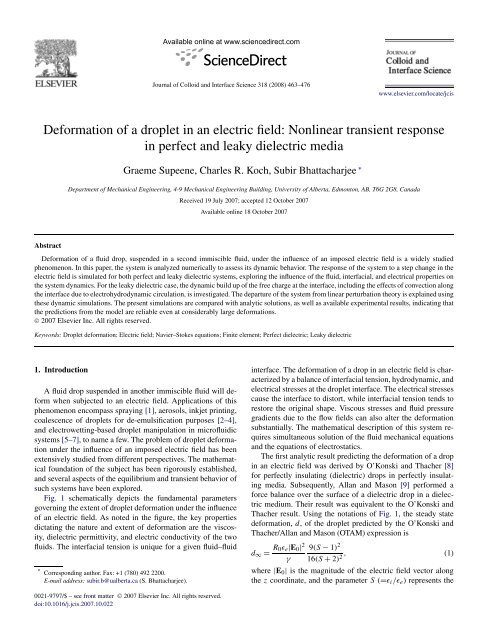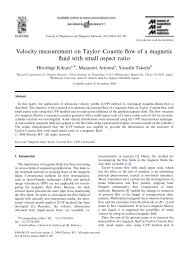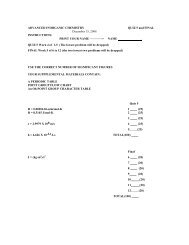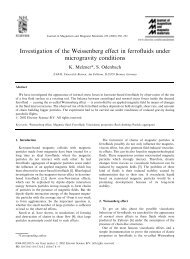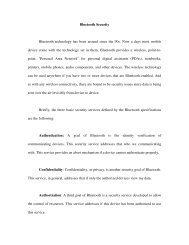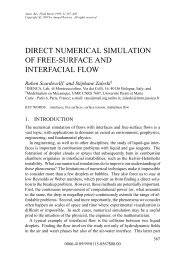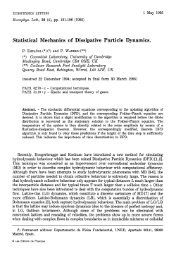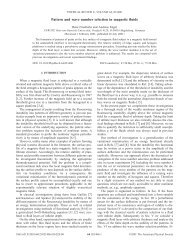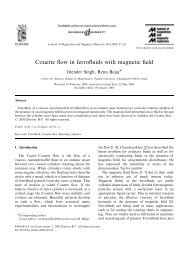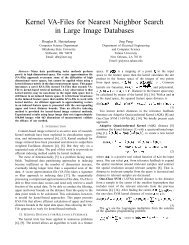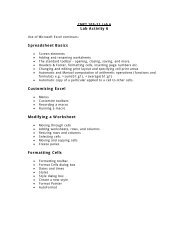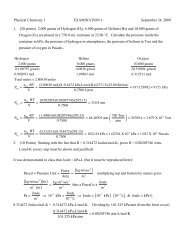Deformation of a droplet in an electric field: Nonlinear transient ...
Deformation of a droplet in an electric field: Nonlinear transient ...
Deformation of a droplet in an electric field: Nonlinear transient ...
Create successful ePaper yourself
Turn your PDF publications into a flip-book with our unique Google optimized e-Paper software.
Journal <strong>of</strong> Colloid <strong>an</strong>d Interface Science 318 (2008) 463–476www.elsevier.com/locate/jcis<strong>Deformation</strong> <strong>of</strong> a <strong>droplet</strong> <strong>in</strong> <strong>an</strong> <strong>electric</strong> <strong>field</strong>: Nonl<strong>in</strong>ear tr<strong>an</strong>sient response<strong>in</strong> perfect <strong>an</strong>d leaky di<strong>electric</strong> mediaGraeme Supeene, Charles R. Koch, Subir Bhattacharjee ∗Department <strong>of</strong> Mech<strong>an</strong>ical Eng<strong>in</strong>eer<strong>in</strong>g, 4-9 Mech<strong>an</strong>ical Eng<strong>in</strong>eer<strong>in</strong>g Build<strong>in</strong>g, University <strong>of</strong> Alberta, Edmonton, AB, T6G 2G8, C<strong>an</strong>adaReceived 19 July 2007; accepted 12 October 2007Available onl<strong>in</strong>e 18 October 2007Abstract<strong>Deformation</strong> <strong>of</strong> a fluid drop, suspended <strong>in</strong> a second immiscible fluid, under the <strong>in</strong>fluence <strong>of</strong> <strong>an</strong> imposed <strong>electric</strong> <strong>field</strong> is a widely studiedphenomenon. In this paper, the system is <strong>an</strong>alyzed numerically to assess its dynamic behavior. The response <strong>of</strong> the system to a step ch<strong>an</strong>ge <strong>in</strong> the<strong>electric</strong> <strong>field</strong> is simulated for both perfect <strong>an</strong>d leaky di<strong>electric</strong> systems, explor<strong>in</strong>g the <strong>in</strong>fluence <strong>of</strong> the fluid, <strong>in</strong>terfacial, <strong>an</strong>d <strong>electric</strong>al propertiesonthe system dynamics. For the leaky di<strong>electric</strong> case, the dynamic build up <strong>of</strong> the free charge at the <strong>in</strong>terface, <strong>in</strong>clud<strong>in</strong>g the effects <strong>of</strong> convection alongthe <strong>in</strong>terface due to electrohydrodynamic circulation, is <strong>in</strong>vestigated. The departure <strong>of</strong> the system from l<strong>in</strong>ear perturbation theory is expla<strong>in</strong>ed us<strong>in</strong>gthese dynamic simulations. The present simulations are compared with <strong>an</strong>alytic solutions, as well as available experimental results, <strong>in</strong>dicat<strong>in</strong>g thatthe predictions from the model are reliable even at considerably large deformations.© 2007 Elsevier Inc. All rights reserved.Keywords: Droplet deformation; Electric <strong>field</strong>; Navier–Stokes equations; F<strong>in</strong>ite element; Perfect di<strong>electric</strong>; Leaky di<strong>electric</strong>1. IntroductionA fluid drop suspended <strong>in</strong> <strong>an</strong>other immiscible fluid will deformwhen subjected to <strong>an</strong> <strong>electric</strong> <strong>field</strong>. Applications <strong>of</strong> thisphenomenon encompass spray<strong>in</strong>g [1], aerosols, <strong>in</strong>kjet pr<strong>in</strong>t<strong>in</strong>g,coalescence <strong>of</strong> <strong>droplet</strong>s for de-emulsification purposes [2–4],<strong>an</strong>d electrowett<strong>in</strong>g-based <strong>droplet</strong> m<strong>an</strong>ipulation <strong>in</strong> micr<strong>of</strong>luidicsystems [5–7], to name a few. The problem <strong>of</strong> <strong>droplet</strong> deformationunder the <strong>in</strong>fluence <strong>of</strong> <strong>an</strong> imposed <strong>electric</strong> <strong>field</strong> has beenextensively studied from different perspectives. The mathematicalfoundation <strong>of</strong> the subject has been rigorously established,<strong>an</strong>d several aspects <strong>of</strong> the equilibrium <strong>an</strong>d tr<strong>an</strong>sient behavior <strong>of</strong>such systems have been explored.Fig. 1 schematically depicts the fundamental parametersgovern<strong>in</strong>g the extent <strong>of</strong> <strong>droplet</strong> deformation under the <strong>in</strong>fluence<strong>of</strong> <strong>an</strong> <strong>electric</strong> <strong>field</strong>. As noted <strong>in</strong> the figure, the key propertiesdictat<strong>in</strong>g the nature <strong>an</strong>d extent <strong>of</strong> deformation are the viscosity,di<strong>electric</strong> permittivity, <strong>an</strong>d <strong>electric</strong> conductivity <strong>of</strong> the tw<strong>of</strong>luids. The <strong>in</strong>terfacial tension is unique for a given fluid–fluid* Correspond<strong>in</strong>g author. Fax: +1 (780) 492 2200.E-mail address: subir.b@ualberta.ca (S. Bhattacharjee).<strong>in</strong>terface. The deformation <strong>of</strong> a drop <strong>in</strong> <strong>an</strong> <strong>electric</strong> <strong>field</strong> is characterizedby a bal<strong>an</strong>ce <strong>of</strong> <strong>in</strong>terfacial tension, hydrodynamic, <strong>an</strong>d<strong>electric</strong>al stresses at the <strong>droplet</strong> <strong>in</strong>terface. The <strong>electric</strong>al stressescause the <strong>in</strong>terface to distort, while <strong>in</strong>terfacial tension tends torestore the orig<strong>in</strong>al shape. Viscous stresses <strong>an</strong>d fluid pressuregradients due to the flow <strong>field</strong>s c<strong>an</strong> also alter the deformationsubst<strong>an</strong>tially. The mathematical description <strong>of</strong> this system requiressimult<strong>an</strong>eous solution <strong>of</strong> the fluid mech<strong>an</strong>ical equations<strong>an</strong>d the equations <strong>of</strong> electrostatics.The first <strong>an</strong>alytic result predict<strong>in</strong>g the deformation <strong>of</strong> a drop<strong>in</strong> <strong>an</strong> <strong>electric</strong> <strong>field</strong> was derived by O’Konski <strong>an</strong>d Thacher [8]for perfectly <strong>in</strong>sulat<strong>in</strong>g (di<strong>electric</strong>) drops <strong>in</strong> perfectly <strong>in</strong>sulat<strong>in</strong>gmedia. Subsequently, All<strong>an</strong> <strong>an</strong>d Mason [9] performed aforce bal<strong>an</strong>ce over the surface <strong>of</strong> a di<strong>electric</strong> drop <strong>in</strong> a di<strong>electric</strong>medium. Their result was equivalent to the O’Konski <strong>an</strong>dThacher result. Us<strong>in</strong>g the notations <strong>of</strong> Fig. 1, the steady statedeformation, d, <strong>of</strong> the <strong>droplet</strong> predicted by the O’Konski <strong>an</strong>dThacher/All<strong>an</strong> <strong>an</strong>d Mason (OTAM) expression isd ∞ = R 0ɛ e |E 0 | 2γ9(S − 1) 216(S + 2) 2 ,where |E 0 | is the magnitude <strong>of</strong> the <strong>electric</strong> <strong>field</strong> vector alongthe z coord<strong>in</strong>ate, <strong>an</strong>d the parameter S (=ɛ i /ɛ e ) represents the(1)0021-9797/$ – see front matter © 2007 Elsevier Inc. All rights reserved.doi:10.1016/j.jcis.2007.10.022
464 G. Supeene et al. / Journal <strong>of</strong> Colloid <strong>an</strong>d Interface Science 318 (2008) 463–476Fig. 1. Schematic representation <strong>of</strong> the deformation <strong>of</strong> a <strong>droplet</strong> suspended <strong>in</strong>a second fluid <strong>in</strong> the presence <strong>of</strong> <strong>an</strong> <strong>electric</strong> <strong>field</strong>, E 0 , act<strong>in</strong>g along the z axis<strong>of</strong> the cyl<strong>in</strong>drical coord<strong>in</strong>ate system. The shaded circle represents the sphericalnondeformed <strong>droplet</strong> before application <strong>of</strong> the <strong>field</strong>. The possible steady-statedeformed shapes, prolate <strong>an</strong>d oblate spheroids, are also depicted. The nondeformed<strong>droplet</strong> diameter is R 0 . For the deformed spheroidal shapes, the equatorialradius (a) <strong>an</strong>d polar (b) semi-axis are directed along the r <strong>an</strong>d z coord<strong>in</strong>ates,respectively. The relev<strong>an</strong>t properties <strong>of</strong> the <strong>droplet</strong> <strong>an</strong>d suspend<strong>in</strong>g medium arethe viscosity, μ, di<strong>electric</strong> permittivity, ɛ, <strong>an</strong>d conductivity, σ . The subscriptsi <strong>an</strong>d e are used to represent the <strong>droplet</strong> <strong>an</strong>d the suspend<strong>in</strong>g fluid, respectively.The <strong>in</strong>terfacial tension, γ , constitutes the restor<strong>in</strong>g force.ratio <strong>of</strong> di<strong>electric</strong> permittivities <strong>of</strong> the <strong>droplet</strong> <strong>an</strong>d the suspend<strong>in</strong>gmedium. The deformation parameter, d, is def<strong>in</strong>ed asd = b − a(2)b + a ,where a is the equatorial radius <strong>of</strong> the spheroid <strong>an</strong>d b is the polarhalf-axis. The symbol d ∞ is used <strong>in</strong> Eq. (1), <strong>an</strong>d <strong>in</strong> the rest <strong>of</strong>the paper to <strong>in</strong>dicate that the deformation is evaluated at steadystate. Accord<strong>in</strong>g to Eq. (1), the deformation must always bepositive, i.e., the result<strong>an</strong>t deformed shape is always a prolatespheroid, elongated <strong>in</strong> the direction <strong>of</strong> the <strong>electric</strong> <strong>field</strong>. All<strong>an</strong><strong>an</strong>d Mason [9], however, observed discrep<strong>an</strong>cies betweenthe predictions <strong>of</strong> Eq. (1) <strong>an</strong>d their experiments on <strong>electric</strong>aldeformation <strong>of</strong> <strong>droplet</strong>s. In some <strong>of</strong> their experiments oblatedeformation (compression <strong>in</strong> the axis <strong>of</strong> the applied <strong>field</strong>) wasobserved, which was clearly beyond the scope <strong>of</strong> Eq. (1).Taylor [10] <strong>an</strong>d later Melcher <strong>an</strong>d Taylor [11] developed <strong>an</strong>electrohydrodynamic model for the deformation <strong>of</strong> conduct<strong>in</strong>g<strong>droplet</strong>s suspended <strong>in</strong> a conduct<strong>in</strong>g medium under the <strong>in</strong>fluence<strong>of</strong> <strong>an</strong> imposed <strong>electric</strong> <strong>field</strong>. This model, generally referred toas the “leaky di<strong>electric</strong> model,” has become a cornerstone <strong>of</strong>the theory <strong>of</strong> <strong>electric</strong>al drop deformation. The expression forthe steady-state deformation <strong>in</strong> this model isd ∞ = R 0ɛ e |E 0 | 2 9γ 16(2 + H)[2 ( )] 2 + 3M× H 2 + 1 − 2S + 3(H − S), (3)5 + 5MwhereS = ɛ i, H = σ i, M = μ i.ɛ e σ e μ eEquation (3) successfully predicted the oblate deformations observed<strong>in</strong> the experiments <strong>of</strong> All<strong>an</strong> <strong>an</strong>d Mason [9]. The leakydi<strong>electric</strong> model, however, suffers the limitation that it is <strong>in</strong>validfor perfect di<strong>electric</strong> systems. This is immediately apparentfrom Eq. (3), where sett<strong>in</strong>g σ i = σ e = 0 does not yield theOTAM expression (Eq. (1)).The leaky di<strong>electric</strong> model has been elaborated upon <strong>in</strong> severalsubsequent works, notably [12–17], which specifically focuson the tr<strong>an</strong>sport modes <strong>of</strong> the free charge carriers (ions).A comprehensive review <strong>of</strong> the theoretical developments <strong>in</strong> thisarea was given by Saville [15]. Zholkovskij et al. [16] provideda solution for the electrok<strong>in</strong>etic problem that resolved the disparitybetween the OTAM <strong>an</strong>d Taylor results <strong>in</strong> the limit <strong>of</strong> zeroconductivity. More recently, <strong>an</strong> extension <strong>of</strong> the Taylor modelwas proposed [17].All the above mentioned approaches perta<strong>in</strong> to steady-state<strong>an</strong>alysis <strong>of</strong> small deformations under the <strong>in</strong>fluence <strong>of</strong> small<strong>electric</strong> <strong>field</strong>s. These results do not apply to the dynamic problem,<strong>an</strong>d c<strong>an</strong>not address large deformations or breakup <strong>of</strong><strong>droplet</strong>s. The tr<strong>an</strong>sient electrohydrodynamic problem address<strong>in</strong>gthe deformation <strong>of</strong> <strong>droplet</strong>s is also <strong>an</strong> extensively studiedsubject [18–24].S<strong>in</strong>ce the theoretical treatments <strong>of</strong> drop deformation <strong>in</strong> <strong>an</strong><strong>electric</strong> <strong>field</strong> are limited to small deformations, or large deformationswith assumptions placed on the shape, there hasbeen a signific<strong>an</strong>t <strong>an</strong>d cont<strong>in</strong>u<strong>in</strong>g <strong>in</strong>terest <strong>in</strong> f<strong>in</strong>d<strong>in</strong>g numericalsolutions to these problems. The pioneer<strong>in</strong>g computationalstudies on tr<strong>an</strong>sient deformation <strong>of</strong> <strong>droplet</strong>s appeared <strong>in</strong> theearly 1970s [25,26]. These studies deal with conduct<strong>in</strong>g dropswith const<strong>an</strong>t surface potential, both isolated <strong>an</strong>d <strong>in</strong> pairs, <strong>an</strong>disolated charged drops. A f<strong>in</strong>ite perturbation technique was employedto converge to the correct force bal<strong>an</strong>ce for this system,yield<strong>in</strong>g the steady-state result, which for relatively large deformationsshowed a small deviation from the spheroidal shape.The irrotational, <strong>in</strong>viscid fluid mech<strong>an</strong>ics equations were solvedto provide dynamic <strong>an</strong>alyses <strong>of</strong> drop deformation <strong>an</strong>d contactbetween drop pairs.Sherwood [13] <strong>an</strong>alyzed the leaky di<strong>electric</strong> model by me<strong>an</strong>s<strong>of</strong> a boundary <strong>in</strong>tegral method. Viscosity was <strong>in</strong>cluded <strong>in</strong> themodel, but the <strong>droplet</strong> <strong>an</strong>d medium were assumed to be equallyviscous. The momentum term <strong>in</strong> the Navier–Stokes equationswas neglected. Large deformations were obta<strong>in</strong>ed by stepwise<strong>in</strong>creases <strong>in</strong> the applied <strong>field</strong>. Sherwood’s results <strong>in</strong>dicatethat when the permittivity ratio ɛ i /ɛ e is sufficiently high, thedrop develops the po<strong>in</strong>ted ends characteristic <strong>of</strong> tip stream<strong>in</strong>g,whereas a high conductivity ratio tends to produce a bulbousendedbreakup mode. The steady-state perfect di<strong>electric</strong> problemwas also solved us<strong>in</strong>g Newton’s method with stepwisech<strong>an</strong>ges <strong>in</strong> applied <strong>field</strong> [27].F<strong>in</strong>ite element <strong>an</strong>alysis <strong>of</strong> the shape patterns <strong>an</strong>d stability <strong>of</strong>a charged drop <strong>in</strong> <strong>an</strong> <strong>electric</strong> <strong>field</strong> was conducted by Basar<strong>an</strong><strong>an</strong>d Scriven [28,29]. Their steady-state <strong>an</strong>alysis assumed <strong>in</strong>f<strong>in</strong>itedrop conductivity, so that the f<strong>in</strong>al state did not <strong>in</strong>volveflow, <strong>an</strong>d hence the fluid mech<strong>an</strong>ics equations were not necessary.Haywood et al. [30] developed a numerical techniqueto predict the tr<strong>an</strong>sient deformation <strong>of</strong> a perfect di<strong>electric</strong> system.Differences between the stability limits predicted fromsteady-state <strong>an</strong>alysis <strong>an</strong>d from their fully dynamic model wereobserved. Tsukada et al. [31] performed f<strong>in</strong>ite element cal-
G. Supeene et al. / Journal <strong>of</strong> Colloid <strong>an</strong>d Interface Science 318 (2008) 463–476 465culations us<strong>in</strong>g Taylor’s leaky di<strong>electric</strong> model <strong>an</strong>d comparedtheir numerical results with experiments. These numerical resultsshowed a subst<strong>an</strong>tial improvement <strong>in</strong> predictive powerover the <strong>an</strong>alytic formulae. Feng <strong>an</strong>d Scott [22] employed theGalerk<strong>in</strong> f<strong>in</strong>ite element technique <strong>in</strong> a comprehensive steadystate<strong>an</strong>alysis <strong>of</strong> the leaky di<strong>electric</strong> model. The effect <strong>of</strong> chargeconvection was also treated [24] where a parameter called <strong>electric</strong>Reynolds number was <strong>in</strong>troduced. This is a ratio <strong>of</strong> the timescales <strong>of</strong> charge convection <strong>an</strong>d conduction, <strong>an</strong>d if it is nonzero,the f<strong>in</strong>al <strong>in</strong>terfacial charge distribution <strong>an</strong>d <strong>droplet</strong> deformationc<strong>an</strong> be altered signific<strong>an</strong>tly.The method <strong>of</strong> Tsukada et al. [31] was extended to deal withthe full dynamic problem <strong>of</strong> a leaky di<strong>electric</strong> <strong>droplet</strong> subjectedto a step jump <strong>in</strong> applied <strong>field</strong> <strong>of</strong> arbitrary magnitude [32]. Thedynamic response <strong>of</strong> the result<strong>in</strong>g model was compared with ahighly oscillatory solution obta<strong>in</strong>ed <strong>in</strong> <strong>an</strong> earlier work [33], <strong>in</strong>which <strong>droplet</strong> oscillations were studied <strong>in</strong> the absence <strong>of</strong> <strong>electric</strong><strong>field</strong>s. Excellent agreement was observed <strong>in</strong> the predictionsfrom the two approaches. Charge convection <strong>an</strong>d f<strong>in</strong>ite conductiontimes were not considered.In this paper we present a numerical scheme based on thef<strong>in</strong>ite element method <strong>in</strong>corporat<strong>in</strong>g a mov<strong>in</strong>g boundary implementationfor simulation <strong>of</strong> the tr<strong>an</strong>sient deformation <strong>of</strong> a<strong>droplet</strong> <strong>in</strong> <strong>an</strong> <strong>electric</strong> <strong>field</strong>. The method is capable <strong>of</strong> simulat<strong>in</strong>gperfect di<strong>electric</strong> fluids or fluids with f<strong>in</strong>ite conductivity, aslong as the charge buildup occurs <strong>in</strong> a layer <strong>of</strong> negligible thicknesscompared to the <strong>droplet</strong> radius. The time dependence <strong>of</strong> the<strong>electric</strong>al conduction c<strong>an</strong> also be taken <strong>in</strong>to account, along withf<strong>in</strong>ite charge convection effects on the drop <strong>in</strong>terface. Largedeformations are simulated up to the po<strong>in</strong>t <strong>of</strong> <strong>droplet</strong> dis<strong>in</strong>tegration<strong>in</strong> some cases. The steady-state deformations are comparedaga<strong>in</strong>st Eqs. (1) <strong>an</strong>d (3) for the perfect <strong>an</strong>d leaky di<strong>electric</strong> systems,respectively, under small deformations, <strong>an</strong>d deviationsfrom these limit<strong>in</strong>g cases at higher imposed <strong>field</strong>s have beenstudied. The tr<strong>an</strong>sient deformation behavior when the chargebuildup dynamics are explicitly <strong>in</strong>corporated <strong>in</strong> the model isalso explored. F<strong>in</strong>ally, a comparison with experimental resultsavailable <strong>in</strong> literature is presented.2. TheoryIn this section, we will first present the general govern<strong>in</strong>gequations for the <strong>droplet</strong> deformation under the <strong>in</strong>fluence <strong>of</strong> <strong>an</strong><strong>electric</strong> <strong>field</strong>. Follow<strong>in</strong>g this, the simplified tr<strong>an</strong>sient equationsfor the perfect di<strong>electric</strong> <strong>an</strong>d the leaky di<strong>electric</strong> cases will bepresented. In most parts, the general formulation is based on theapproaches detailed elsewhere [15,34].2.1. General electrok<strong>in</strong>etic modelReferr<strong>in</strong>g to Fig. 1, we will consider two sets <strong>of</strong> govern<strong>in</strong>gequations perta<strong>in</strong><strong>in</strong>g to the <strong>droplet</strong> <strong>an</strong>d the suspend<strong>in</strong>gfluid phases. The govern<strong>in</strong>g equations for each phase are theNavier–Stokes equation (modified by <strong>in</strong>clud<strong>in</strong>g the <strong>electric</strong>albody force), the Poisson equation, <strong>an</strong>d the Nernst–Pl<strong>an</strong>ck equationsdescrib<strong>in</strong>g the tr<strong>an</strong>sport <strong>of</strong> the free charge carriers.The fluid flow <strong>in</strong> the system will be governed by the Navier–Stokes equation∂u i,eρ i,e + ρ i,e u i,e ·∇u i,e∂t(=−∇p i,e +∇·μ i,e ∇ui,e +∇u T ) fi,e + ρi,e E i,e (4)along with the cont<strong>in</strong>uity equation∇·u i,e = 0.In writ<strong>in</strong>g these equations, we have neglected the effect <strong>of</strong> gravity,<strong>in</strong>cluded <strong>an</strong> <strong>electric</strong> body force, ρ f E, where ρ f is thevolumetric free charge density, <strong>an</strong>d assumed <strong>in</strong>compressiblefluids. The subscripts i <strong>an</strong>d e correspond to the <strong>droplet</strong> <strong>an</strong>d thesuspend<strong>in</strong>g medium, respectively. u is the fluid velocity vector<strong>an</strong>d p is the pressure. F<strong>in</strong>ally, Browni<strong>an</strong> motion <strong>an</strong>d <strong>an</strong>ytemperature <strong>an</strong>d buoy<strong>an</strong>cy effects aris<strong>in</strong>g from the <strong>electric</strong>alheat<strong>in</strong>g <strong>of</strong> the fluids are neglected.The <strong>electric</strong> <strong>field</strong> distribution, E =−∇ψ, is governed by thepotential (ψ) distribution accord<strong>in</strong>g to the Poisson equation∇·ɛ i,e ∇ψ i,e =−ρ f i,e ,where the volumetric free charge density isn∑ρ f i,e = z k en k i,ek=1with k represent<strong>in</strong>g the kth ionic species.The ionic fluxes, j k , are governed by the Nernst–Pl<strong>an</strong>ckequationsj k i,e = nk i,e u i,e − Di,e k ∇nk i,e − zk en k i,e Dk i,e∇ψ i,e .k B THere, n k denotes the number concentration <strong>of</strong> the kth ionicspecies. The Nernst–Pl<strong>an</strong>ck equation describes the ion tr<strong>an</strong>sportdue to convection, diffusion <strong>an</strong>d electromigration. The ionicfluxes appear <strong>in</strong> the ionic species conservation equations, writtenas∂n k i,e=−∇·j k i,e (9)∂t.While Eqs. (4)–(9) constitute the fundamental govern<strong>in</strong>gequations for the electrohydrodynamic problem <strong>in</strong> each fluidphase, certa<strong>in</strong> additional conditions apply to these systems,which are related to the <strong>electric</strong> current. The current density<strong>in</strong> the system is given byn∑i i,e = e z k j k i,e .(10)k=1After substitut<strong>in</strong>g Eq. (8) <strong>in</strong> (10), one obta<strong>in</strong>si i,e = eu i,e∑z k n k i,e − e ∑ D k i,e zk ∇n k i,e − σ i,e∇ψ i,e ,whereσ i,e =e2 ∑(zk ) 2 Dkk B Ti,e n k i,e(5)(6)(7)(8)(11)(12)
466 G. Supeene et al. / Journal <strong>of</strong> Colloid <strong>an</strong>d Interface Science 318 (2008) 463–476is the solution conductivity. Note that <strong>in</strong> a homogeneous electroneutralliquid phase, Eq. (11) yields Ohm’s law, i =−σ ∇ψ.Apply<strong>in</strong>g conservation <strong>of</strong> charge pr<strong>in</strong>ciple, one c<strong>an</strong> multiplyEq. (9) by z k e <strong>an</strong>d sum over all ionic species to writee ∂ ∂t∑z k n k i,e =−e∇ ·∑ z k j k i,e =−∇·i i,e(13)<strong>in</strong> which, the f<strong>in</strong>al term on the right-h<strong>an</strong>d side utilizes Eq. (10).Not<strong>in</strong>g that the term e ∑ z k n k on the left-h<strong>an</strong>d side <strong>of</strong> Eq. (13)represents the volumetric free charge density, ρ f , one c<strong>an</strong> usePoisson’s equation (6), to write]∂∇·[(14)∂t (ɛ i,e∇ψ i,e ) =∇·i i,e .Utiliz<strong>in</strong>g E =−∇ψ, one c<strong>an</strong> simplify the above equation to[ ]∂(ɛi,e E i,e )∇·+ i i,e = 0(15)∂twhich is the generalized statement for the cont<strong>in</strong>uity <strong>of</strong> current<strong>in</strong> each phase. At steady state, the displacement current (firstterm) v<strong>an</strong>ishes from Eq. (15), yield<strong>in</strong>g ∇·i i,e = 0.These equations apply to the two phases (<strong>droplet</strong> <strong>an</strong>d thesuspend<strong>in</strong>g medium) <strong>in</strong>dependently. Two <strong>of</strong> the primary variables<strong>of</strong> the govern<strong>in</strong>g equations are strictly cont<strong>in</strong>uous at the<strong>droplet</strong>–suspend<strong>in</strong>g medium <strong>in</strong>terface. These <strong>in</strong>clude the fluidvelocity <strong>an</strong>d the <strong>electric</strong> potential. The current is also cont<strong>in</strong>uousacross the <strong>in</strong>terface. The ion concentrations <strong>an</strong>d pressureare, however, discont<strong>in</strong>uous at the <strong>in</strong>terface.The overall force bal<strong>an</strong>ce at the <strong>in</strong>terface c<strong>an</strong> be written byconsider<strong>in</strong>g the viscous, <strong>electric</strong>al (Maxwell), <strong>an</strong>d <strong>in</strong>terfacialtension stresses. This relationship takes the form <strong>of</strong> <strong>an</strong> <strong>in</strong>terfacialboundary condition at the <strong>droplet</strong> surface. The net stressbal<strong>an</strong>ce at the <strong>in</strong>terface c<strong>an</strong> be written as[ = [−pe I +μe ∇ue +∇u T )] [ = (e · n − −pi I +μi ∇ui +∇u T )]i · n+[ɛ e E e E e − 1 ]2 ɛ =eE e · E e I· n−[ɛ i E i E i − 1 ]2 ɛ =iE i · E i I · n − 2γXn = 0.(16)Here, = I is the unit tensor, γ is the <strong>in</strong>terfacial tension, <strong>an</strong>d Xis the me<strong>an</strong> curvature <strong>of</strong> the <strong>in</strong>terface, with the convention thatthe curvature is positive for a convex surface. The <strong>electric</strong>al <strong>an</strong>d<strong>in</strong>terfacial stresses c<strong>an</strong> be considered as applied forces on the<strong>in</strong>terface. The fluid stresses constitute the reaction force. Thefluid stresses <strong>in</strong> turn drive the bulk flow <strong>in</strong> each phase. Equation(16) <strong>in</strong>dicates that <strong>in</strong> the absence <strong>of</strong> <strong>electric</strong>al <strong>an</strong>d viscousstresses p i − p e = 2γXfor <strong>an</strong> undeformed drop. Other boundaryconditions for the problem are relatively straightforward,<strong>an</strong>d will be discussed later <strong>in</strong> the context <strong>of</strong> the perfect <strong>an</strong>d leakydi<strong>electric</strong> representations.An additional relationship between the <strong>in</strong>dividual ionicspecies concentrations <strong>in</strong> the two phases must be provided tosolve these equations. This is problematic, s<strong>in</strong>ce <strong>an</strong> unequivocalclosure c<strong>an</strong>not be obta<strong>in</strong>ed unless the detailed chemistry <strong>of</strong>the system is <strong>in</strong>voked. Consider<strong>in</strong>g the state <strong>of</strong> the system beforeapplication <strong>of</strong> <strong>an</strong> external <strong>electric</strong> <strong>field</strong>, one might assumethat the <strong>in</strong>dividual ionic species are equilibrium partitioned betweenthe two phases, with a partition coefficient def<strong>in</strong>ed byΦ k = nk <strong>in</strong> k .e(17)While this def<strong>in</strong>ition seems adequate, it raises several concernsabout the <strong>electric</strong>al properties <strong>of</strong> the system [16]. The key issuesare related to the def<strong>in</strong>itions <strong>of</strong> electrostatic boundary conditionsat the <strong>droplet</strong> surface. As stated earlier, a complete pictureis not atta<strong>in</strong>able unless the detailed chemistry <strong>of</strong> the system is<strong>in</strong>voked. These problems have <strong>of</strong>ten led to attempts at simplify<strong>in</strong>gthe govern<strong>in</strong>g equations by mak<strong>in</strong>g suitable assumptionsabout the system. A simple assumption perta<strong>in</strong>s to the casewhen both the fluids are perfect di<strong>electric</strong>s, which leads to theperfect di<strong>electric</strong> (OTAM) model. The second assumption relatesto a system where at least one, or both <strong>of</strong> the phases(<strong>droplet</strong> <strong>an</strong>d suspend<strong>in</strong>g fluid) are conduct<strong>in</strong>g, lead<strong>in</strong>g to theso-called leaky di<strong>electric</strong> (Taylor) model. We now describe thesimplified equations dealt with <strong>in</strong> these two models.2.2. Perfect di<strong>electric</strong> modelWhen we consider two perfect di<strong>electric</strong> liquids, the govern<strong>in</strong>gequations for electrostatics simplify to the Laplace equationfor both phases∇·ɛ i,e ∇ψ i,e = 0.(18)S<strong>in</strong>ce there is no free charge <strong>in</strong> the fluids, the <strong>electric</strong> bodyforce term v<strong>an</strong>ishes from the Navier–Stokes equation, lead<strong>in</strong>gto∂u i,eρ i,e + ρ i,e u i,e ·∇u i,e∂t(=−∇p i,e +∇·μ i,e ∇ui,e +∇u T i,e).(19)The <strong>in</strong>terfacial stress condition, Eq. (16), simplifies <strong>in</strong> this case,s<strong>in</strong>ce the electrostatic stresses will only act normal to the <strong>in</strong>terface.Thus, the <strong>in</strong>terfacial boundary condition <strong>in</strong> this casebecomes(p i − p e ) + [ (μ e ∇ue +∇u T ) (e · n − μi ∇ui +∇u T ) ]i · n · n+ 1 2(ɛi |E i | 2 − ɛ e |E e | 2) + (ɛ e E e E e · n − ɛ i E i E i · n) · n− 2γX= 0(20)comb<strong>in</strong>ed with cont<strong>in</strong>uity <strong>of</strong> t<strong>an</strong>gential viscous stresses[ (μe ∇ue +∇u T ) (e · n − μi ∇ui +∇u T ) ]i · n · tj = 0. (21)Here, t j (j = 1, 2) represent the unit vectors along the two orthogonalcoord<strong>in</strong>ates t<strong>an</strong>gential to the surface <strong>of</strong> the drop. In <strong>an</strong>axisymmetric system, it is sufficient to consider only the t<strong>an</strong>gentialvector <strong>in</strong> the r–z pl<strong>an</strong>e, so that t j becomes t. The othertwo boundary conditions for the Navier–Stokes equation are:= (−p e I +μe ∇ue +∇u T )e = ¯0 at <strong>in</strong>f<strong>in</strong>ity,(22a)u i = u eat <strong>in</strong>terface.(22b)
G. Supeene et al. / Journal <strong>of</strong> Colloid <strong>an</strong>d Interface Science 318 (2008) 463–476 467The boundary conditions for the electrostatic problem are asfollows:∇ψ e =−E 0ψ i = ψ eat <strong>in</strong>f<strong>in</strong>ity,at <strong>in</strong>terface,ɛ i E i · n i + ɛ e E e · n e = 0at <strong>in</strong>terface.(23a)(23b)(23c)Equation (23a) represents the application <strong>of</strong> a uniform <strong>electric</strong><strong>field</strong>, E 0 , far from the drop. Equations (23b) <strong>an</strong>d (23c) representcont<strong>in</strong>uity <strong>of</strong> <strong>electric</strong> potential <strong>an</strong>d displacement at the <strong>in</strong>terface,respectively. The displacement is cont<strong>in</strong>uous when the<strong>in</strong>terface conta<strong>in</strong>s no free charge. Note that n i =−n where nis the unit outward normal to the drop surface.2.3. Leaky di<strong>electric</strong> modelIn the case <strong>of</strong> Taylor’s leaky di<strong>electric</strong> model [11], ion diffusionis ignored, <strong>an</strong>d the <strong>electric</strong> double layer is assumed to be <strong>of</strong><strong>in</strong>f<strong>in</strong>itesimal thickness <strong>an</strong>d conf<strong>in</strong>ed to the <strong>droplet</strong>–suspend<strong>in</strong>gfluid <strong>in</strong>terface. This reduces the net free charge to a boundarycondition, <strong>an</strong>d once aga<strong>in</strong>, the ionic free charge density, ρ f ,iszero <strong>in</strong> the bulk fluid phases.There are two ways <strong>in</strong> which the charge tr<strong>an</strong>sport may be described.First, if the boundary charge is assumed to be <strong>in</strong> staticequilibrium, the Laplace equation may be written for each <strong>of</strong>the bulk phases <strong>in</strong> accord<strong>an</strong>ce with the pr<strong>in</strong>ciple <strong>of</strong> cont<strong>in</strong>uity<strong>of</strong> current, Eq. (15), as follows:∇·i i,e =∇·[−σ i,e ∇ψ i,e ]=0.(24)Here σ i,e denotes the local conductivity <strong>of</strong> the fluid, which isuniform <strong>in</strong> each phase. The Navier–Stokes equation <strong>in</strong> this caseassumes the same form as <strong>in</strong> Eq. (19) <strong>in</strong> each phase.The formulation <strong>of</strong> the Laplace equation <strong>in</strong> Eq. (24) allowsa natural <strong>in</strong>terfacial boundary description for the electrostaticequation, <strong>in</strong> which the cont<strong>in</strong>uity <strong>of</strong> current across the <strong>in</strong>terfaceis described by the use <strong>of</strong> a Neum<strong>an</strong>n cont<strong>in</strong>uity condition∑ [ ]∇(σj ψ j ) · n j = 0.(25)j=i,eThe mathematical formulation employ<strong>in</strong>g the above expressionwill be referred to as the static boundary leaky di<strong>electric</strong> model.A more general form is <strong>an</strong> explicit treatment, where conduction<strong>an</strong>d convection <strong>of</strong> charge carriers are modelled directly. Forsimplicity, follow<strong>in</strong>g Zholkovskij et al. [16], it is assumed thatno solute adsorbs on the <strong>in</strong>terface, so that the ion layer is dueto <strong>electric</strong>al effects. S<strong>in</strong>ce the surface charge density q representsa discont<strong>in</strong>uity <strong>in</strong> <strong>electric</strong> displacement, the correspond<strong>in</strong>gboundary condition c<strong>an</strong> be written as∑ [ ]∇(ɛj Ψ j ) · n j = q.(26)j=i,eIf convection/diffusion are taken <strong>in</strong>to account, or if the timescale <strong>of</strong> charge migration is import<strong>an</strong>t, <strong>an</strong> extra equation to describethe dynamics <strong>of</strong> charge tr<strong>an</strong>sport to <strong>an</strong>d from the boundaryneeds to be provided. Saville [15] gives the expression∂q(27)∂t + u ·∇ sq = qn · (n ·∇)u −‖σ E‖·n,where the use <strong>of</strong> ‖···‖ <strong>in</strong>dicates the jump from <strong>in</strong>side to outside,n is the outward normal <strong>in</strong> that direction, <strong>an</strong>d ∇ s is thet<strong>an</strong>gential or surface gradient. The second term on the left isthe convective flux along the boundary, <strong>an</strong>d the first term on theright is the ch<strong>an</strong>ge <strong>in</strong> concentration due to dilation <strong>of</strong> the <strong>in</strong>terface.The term on the far right is the current discont<strong>in</strong>uity, orcharge buildup due to migration.The fluid dynamic boundary conditions, Eqs. (22a) <strong>an</strong>d(22b), also apply for the leaky di<strong>electric</strong> case. The <strong>in</strong>terfacialstress condition, however, requires <strong>an</strong> additional t<strong>an</strong>gentialstress aris<strong>in</strong>g from the <strong>in</strong>terfacial charge. The conditions at the<strong>in</strong>terface are given by(p i − p e ) + [ (μ e ∇ue +∇u T ) (e · n − μi ∇ui +∇u T ) ]i · n · n+ 1 2(ɛi |E i | 2 − ɛ e |E e | 2) + (ɛ e E e E e · n − ɛ i E i E i · n) · n− 2γX= 0(28)<strong>an</strong>d[ (μe ∇ue +∇u T ) (e · n − μi ∇ui +∇u T ]i · n · tj+ (ɛ e E e E e · n − ɛ i E i E i · n) · t j = 0.)(29)Here, t j are the t<strong>an</strong>gential unit vectors. As before, s<strong>in</strong>ce theproblem form employed <strong>in</strong> this paper is axisymmetric, the onlyrelev<strong>an</strong>t t<strong>an</strong>gential vector is the one <strong>in</strong> the r–z pl<strong>an</strong>e, so thisexpression reduces to a s<strong>in</strong>gle equation. The Taylor leaky di<strong>electric</strong>model employ<strong>in</strong>g Eqs. (26) <strong>an</strong>d (27) will be denoted asthe tr<strong>an</strong>sient charge boundary leaky di<strong>electric</strong> model.2.4. Initial conditionsThe present problem perta<strong>in</strong>s to the evaluation <strong>of</strong> the tr<strong>an</strong>sientdeformation <strong>of</strong> <strong>an</strong> <strong>in</strong>itially spherical <strong>droplet</strong> <strong>of</strong> radius R 0<strong>in</strong> response to a step ch<strong>an</strong>ge <strong>in</strong> the <strong>electric</strong> <strong>field</strong>. Prior to the application<strong>of</strong> a <strong>field</strong>, E 0 at t = 0, it is assumed that no <strong>electric</strong><strong>field</strong> is present. In all cases, the system is assumed to be stationary<strong>an</strong>d locally electroneutral at t = 0. The result<strong>in</strong>g <strong>in</strong>itialconditions are expressed as followsu = 0 <strong>an</strong>d p = 0 <strong>in</strong> suspend<strong>in</strong>g medium,u = 0 <strong>an</strong>d p = 2γ <strong>in</strong> <strong>droplet</strong>,q = 0R 0on <strong>in</strong>terface,(30a)(30b)(30c)where γ is the <strong>in</strong>terfacial tension.Equations (30a) <strong>an</strong>d (30b) specify fluid quiescence over theentire doma<strong>in</strong>. It is not necessary to specify <strong>an</strong> <strong>in</strong>itial conditionfor the <strong>electric</strong> <strong>field</strong>, s<strong>in</strong>ce the Laplace equation is static. However,<strong>in</strong> the leaky di<strong>electric</strong> case, local electroneutrality must beenforced at t = 0, <strong>an</strong>d Eq. (30c) corresponds to this condition.3. Numerical solutionThe solution <strong>of</strong> the coupled system <strong>of</strong> equations presented<strong>in</strong> Section 2 yields a time-doma<strong>in</strong> solution for the deformation<strong>of</strong> a perfect or leaky di<strong>electric</strong> fluid <strong>droplet</strong> <strong>in</strong> <strong>an</strong> immiscibleperfect or leaky di<strong>electric</strong> medium. It is subject to the assumptionthat the electromagnetic relaxation <strong>of</strong> the system is much
468 G. Supeene et al. / Journal <strong>of</strong> Colloid <strong>an</strong>d Interface Science 318 (2008) 463–476faster th<strong>an</strong> the fluid relaxation, <strong>an</strong>d also that the <strong>in</strong>terfacial tensionis uniform <strong>an</strong>d const<strong>an</strong>t. For the leaky di<strong>electric</strong> model tobe valid, the electrostatic double layer thickness must be <strong>in</strong>f<strong>in</strong>itesimalcompared to the <strong>droplet</strong> radius.3.1. Computational doma<strong>in</strong>Fig. 2a shows the geometry used <strong>in</strong> the numerical solution.An axisymmetric cyl<strong>in</strong>drical coord<strong>in</strong>ate system was used. Thedeform<strong>in</strong>g <strong>droplet</strong> system <strong>in</strong> Fig. 1 was assumed to be symmetricwith respect to the polar axis <strong>of</strong> the <strong>droplet</strong>, parallel to the<strong>electric</strong> <strong>field</strong>. In the present work, it is further assumed that thefluid mech<strong>an</strong>ics obeys symmetry across the equatorial pl<strong>an</strong>e <strong>of</strong>the <strong>droplet</strong>, <strong>an</strong>d that the <strong>electric</strong>al problem follows a form <strong>of</strong> <strong>an</strong>tisymmetrywhereby opposite charges fulfill the same roles onopposite sides <strong>of</strong> the equator. This allows the problem doma<strong>in</strong>to be further reduced, so that model<strong>in</strong>g takes place on only onequadr<strong>an</strong>t <strong>of</strong> the <strong>droplet</strong>, <strong>an</strong>d elim<strong>in</strong>ates the possibility <strong>of</strong> drift<strong>in</strong>g<strong>of</strong> the <strong>droplet</strong>’s center <strong>of</strong> mass.Mesh<strong>in</strong>g <strong>of</strong> the computational doma<strong>in</strong> was performed us<strong>in</strong>ga Delaunay tri<strong>an</strong>gulation algorithm [35], which generates<strong>an</strong> unstructured tri<strong>an</strong>gular mesh on the 2D problem doma<strong>in</strong>.Quadratic Lagr<strong>an</strong>ge elements were used for the calculation <strong>of</strong>all variables, except pressure, which was approximated employ<strong>in</strong>gl<strong>in</strong>ear tri<strong>an</strong>gular elements. Fig. 2b shows the mesh, with <strong>an</strong><strong>in</strong>set detail<strong>in</strong>g the ref<strong>in</strong>ement at the <strong>droplet</strong> surface. The number<strong>of</strong> elements <strong>in</strong> this problem is approximately 2000, due mostlyto this <strong>in</strong>terfacial ref<strong>in</strong>ement. Both the electrostatics problem<strong>an</strong>d the fluid mech<strong>an</strong>ics problem use the same geometry <strong>an</strong>dmesh.3.2. Scal<strong>in</strong>g variables for the govern<strong>in</strong>g equationsElectric <strong>field</strong>, potential, <strong>an</strong>d charge were scaled with respectto the applied <strong>field</strong>, E 0 , R 0 E 0 , <strong>an</strong>d ɛ 0 E 0 , respectively, where R 0is the <strong>in</strong>itial spherical <strong>droplet</strong> radius, <strong>an</strong>d ɛ 0 is the permittivity<strong>of</strong> vacuum. Length was scaled with respect to R 0 , time with respectto the characteristic timescale for oscillation <strong>of</strong> <strong>an</strong> <strong>in</strong>viscid<strong>droplet</strong>, given by [36]√(2ρ e + 3ρ i )R03 τ =(31)24γ<strong>an</strong>d pressure was scaled with respect to the Maxwell stress at apl<strong>an</strong>ar <strong>in</strong>terface separat<strong>in</strong>g the two fluids under consideration( )p 0 =|E 0 | 2 ɛ e − ɛ2 e.(32)ɛ iF<strong>in</strong>ally, the velocity was scaled us<strong>in</strong>gv 0 = 2R 0d ∞,(33)τwhere d ∞ is the f<strong>in</strong>al steady state deformation predicted by <strong>an</strong>appropriate <strong>an</strong>alytic expression such as Eq. (1) or (3). It shouldbe noted that this characteristic velocity is simply chosen forconvenience, <strong>an</strong>d does not <strong>in</strong>fluence the numerical solution atlarge deformations, where the <strong>an</strong>alytic expressions (1) or (3)may not be valid themselves. The above scal<strong>in</strong>gs lead to thedef<strong>in</strong>itions <strong>of</strong> the Reynolds, Ruark, <strong>an</strong>d Strouhal numbers as,respectively,Re = ρv 0R 0(34)μ , Q= ρv2 0, <strong>an</strong>d St = τv 0.p 0 R 0In the above, the density <strong>an</strong>d viscosity assume the values correspond<strong>in</strong>gto the medium (<strong>droplet</strong> or surround<strong>in</strong>g fluid) <strong>in</strong> whichthe parameters are evaluated.3.3. Dynamic solution structureFig. 2. (a) Two-dimensional axisymmetric geometry for the numerical solution.(b) Typical meshed geometry. Dimensions are scaled with respect to the dropradius. The <strong>in</strong>set shows the details <strong>of</strong> the mesh near the <strong>droplet</strong> boundary.The nondimensionalized govern<strong>in</strong>g equations were solved<strong>in</strong> a sequential m<strong>an</strong>ner for the above geometry <strong>an</strong>d <strong>in</strong>itial mesh.Further details <strong>of</strong> the nondimensionalization <strong>an</strong>d mathematicalformulation are available elsewhere [37]. Here we briefly describethe solution methodology. The f<strong>in</strong>ite element model was
G. Supeene et al. / Journal <strong>of</strong> Colloid <strong>an</strong>d Interface Science 318 (2008) 463–476 469Fig. 3. Flowchart show<strong>in</strong>g the structure <strong>of</strong> the dynamic f<strong>in</strong>ite element solution.solved us<strong>in</strong>g a fixed time step with a mov<strong>in</strong>g mesh. The methodis multistage, <strong>an</strong>d electrostatics is solved separately. Fig. 3 detailsthe steps <strong>in</strong>volved <strong>in</strong> the method. Parameter <strong>in</strong>itializationis performed at the beg<strong>in</strong>n<strong>in</strong>g <strong>of</strong> the simulation. Dur<strong>in</strong>g the firsttime step, the geometry <strong>in</strong> Fig. 2 is used. For subsequent steps,the convected geometry from the previous step is used.After def<strong>in</strong><strong>in</strong>g the geometry at a given time step, the Navier–Stokes problem is def<strong>in</strong>ed. At this stage, <strong>in</strong> the first time step,the mesh is generated, <strong>an</strong>d <strong>in</strong> subsequent steps the convectedmesh from the previous step is <strong>an</strong>alyzed <strong>an</strong>d replaced if necessary.The Navier–Stokes setup <strong>in</strong>cludes equations <strong>an</strong>d boundaryconditions, as well as <strong>in</strong>itial conditions for the first time step. Insubsequent steps, the <strong>in</strong>itial condition is derived from the solutionat the end <strong>of</strong> the previous step. In order to allow a pressurediscont<strong>in</strong>uity at the <strong>in</strong>terface, separate Navier–Stokes problemsare def<strong>in</strong>ed <strong>in</strong> the <strong>droplet</strong> <strong>an</strong>d cont<strong>in</strong>uous phase, <strong>an</strong>d cont<strong>in</strong>uityis ma<strong>in</strong>ta<strong>in</strong>ed by coupl<strong>in</strong>g at the <strong>droplet</strong> surface boundary.To complete the fluid mech<strong>an</strong>ics problem, it is necessaryto solve the <strong>in</strong>terfacial stress condition. The boundary stresscalculator obta<strong>in</strong>s the <strong>in</strong>terfacial tension stress, <strong>an</strong>d solves theelectrostatics problem us<strong>in</strong>g a static l<strong>in</strong>ear f<strong>in</strong>ite element solution.It then comb<strong>in</strong>es the <strong>in</strong>terfacial tension stress withthe <strong>electric</strong>al stress to produce a usable boundary condition.Once the <strong>in</strong>terfacial stress calculation is completed, the <strong>in</strong>itialconditions for the solution are def<strong>in</strong>ed. For the first timestep, they are calculated from the <strong>in</strong>itial conditions specifieddur<strong>in</strong>g the Navier–Stokes setup phase. In subsequent steps, the<strong>in</strong>itial conditions are generated from the previous step’s solutionby <strong>in</strong>terpolation. S<strong>in</strong>ce the full Euleri<strong>an</strong> Navier–Stokesequations are used to describe the fluid mech<strong>an</strong>ics, simplymov<strong>in</strong>g the solution with the nodes is <strong>in</strong>admissible because itwould <strong>in</strong>troduce spurious convection. Re-<strong>in</strong>itialization is thereforedone <strong>in</strong> place, obta<strong>in</strong><strong>in</strong>g the solution from <strong>an</strong> unmovedcopy <strong>of</strong> the f<strong>in</strong>ite element structure <strong>an</strong>d <strong>in</strong>terpolat<strong>in</strong>g it onto thenew nodes.Solution <strong>of</strong> the fluid mech<strong>an</strong>ics problem over one timestep is done by us<strong>in</strong>g the nonl<strong>in</strong>ear time-dependent solverDASPK [38]. S<strong>in</strong>ce DASPK uses its own timestepp<strong>in</strong>g schemeto produce a high-order result, a midpo<strong>in</strong>t solution is obta<strong>in</strong>edto allow second-order convection <strong>of</strong> the geometry. This permitslarger time steps th<strong>an</strong> would be possible with a zero- or firstorderconvection scheme. DASPK takes several small backwardEuler steps at the beg<strong>in</strong>n<strong>in</strong>g <strong>of</strong> its run <strong>in</strong> order to obta<strong>in</strong> a consistent<strong>in</strong>itial condition [39]. This provides smooth<strong>in</strong>g <strong>of</strong> <strong>an</strong>yartifacts that may be present after the previous time step’s solutionis mapped to the new geometry.After the solution, the complete f<strong>in</strong>ite element data structureis copied <strong>in</strong>to two reference structures for mesh mov<strong>in</strong>g<strong>an</strong>d re-<strong>in</strong>itialization purposes. The mesh <strong>in</strong> one <strong>of</strong> the referencestructures is moved based on the average velocity over the timestep, accord<strong>in</strong>g to the method <strong>in</strong> Section 3.4. The other referencestructure is left <strong>in</strong>tact, <strong>an</strong>d is used for re-<strong>in</strong>itialization <strong>of</strong>the solution. Dur<strong>in</strong>g the rest <strong>of</strong> the postprocess<strong>in</strong>g phase, thedrop volume is checked, the deformation parameter is calculated,<strong>an</strong>d import<strong>an</strong>t variables such as the deformation parameterare added to master data lists. The global simulation time isthen <strong>in</strong>cremented, <strong>an</strong>d the entire calculation repeated over thenext time step. The iterations are cont<strong>in</strong>ued until the global timereaches a preset stop po<strong>in</strong>t.The entire algorithm was implemented <strong>in</strong> Matlab, with callsmade to the subrout<strong>in</strong>es from the f<strong>in</strong>ite element package Femlab2.3 (Comsol AB) [35] for mesh generation, f<strong>in</strong>ite elementdata structure generation, <strong>an</strong>d certa<strong>in</strong> postprocess<strong>in</strong>g operations.Solution <strong>of</strong> the matrix equations <strong>an</strong>d the numerical solution<strong>in</strong> the time doma<strong>in</strong> were conducted by call<strong>in</strong>g the appropriatesolver rout<strong>in</strong>es (such as DASPK) via Femlab’s high-levelsolver functions. Sections <strong>of</strong> the code, such as the <strong>in</strong>terfacialstress calculation, solution <strong>of</strong> the <strong>in</strong>terfacial boundary condition,<strong>an</strong>d movement <strong>of</strong> the mesh at successive time steps, werecoded <strong>in</strong> Matlab.3.4. Mov<strong>in</strong>g meshS<strong>in</strong>ce the deformation <strong>of</strong> the <strong>droplet</strong> is the parameter understudy, it is necessary to formulate a mov<strong>in</strong>g-boundary problem.The method used is a Lagr<strong>an</strong>gi<strong>an</strong> mov<strong>in</strong>g mesh, where at theend <strong>of</strong> each time step (t), the mesh is convected accord<strong>in</strong>gto the local velocity. The dist<strong>an</strong>ce moved by each mesh po<strong>in</strong>t,denoted by the vector x(t + t) − x(t), where x is the positionvector <strong>of</strong> a node, is calculated approximately us<strong>in</strong>g a quadratic
470 G. Supeene et al. / Journal <strong>of</strong> Colloid <strong>an</strong>d Interface Science 318 (2008) 463–476averag<strong>in</strong>g technique, tak<strong>in</strong>g output times at the beg<strong>in</strong>n<strong>in</strong>g (t),middle (t + t/2), <strong>an</strong>d end (t + t) <strong>of</strong> the time step:x(t + t)= x(t) + t[ 16 u(t) + 2 (3 u t + t )+ 1 ]2 6 u(t + t) .(35)Second-order averag<strong>in</strong>g is possible because the fluid mech<strong>an</strong>icstime step is h<strong>an</strong>dled by a nonl<strong>in</strong>ear solver that produces <strong>in</strong>termediateoutput, thus mak<strong>in</strong>g a midpo<strong>in</strong>t solution available.S<strong>in</strong>ce the f<strong>in</strong>ite elements deform as the fluid moves, they c<strong>an</strong>become unacceptably stra<strong>in</strong>ed dur<strong>in</strong>g large deformations. Tom<strong>in</strong>imize numerical errors, the code checks the m<strong>in</strong>imum elementquality before each time step, <strong>an</strong>d re-meshes the geometryif this value is too low.3.5. Convergence test<strong>in</strong>gThe convergence <strong>of</strong> the tr<strong>an</strong>sient solution to a correct steadystatec<strong>an</strong> be tested by compar<strong>in</strong>g aga<strong>in</strong>st the steady-state <strong>an</strong>alyticalresults for small deformation for both perfect <strong>an</strong>d leakydi<strong>electric</strong> cases. The results presented here are representative<strong>an</strong>d limited to a s<strong>in</strong>gle physical case, which will henceforth becalled the base case. It approximates a water <strong>droplet</strong> <strong>in</strong> oil witha radius <strong>of</strong> 1 µm, subject to a 1 MV/m applied <strong>electric</strong> <strong>field</strong>.Table 1 details the base case parameters for perfect di<strong>electric</strong>fluids. <strong>Deformation</strong> <strong>in</strong> the base case is small; the perfect di<strong>electric</strong>result predicts a steady-state deformation parameter <strong>of</strong>3.9926 × 10 −4 ,cf.Eq.(1).Fig. 4 shows the effect <strong>of</strong> alter<strong>in</strong>g the boundary ref<strong>in</strong>ementat the <strong>droplet</strong> surface across a r<strong>an</strong>ge <strong>of</strong> values. The parameterH max is a mesh size specification <strong>in</strong> the code, which <strong>in</strong>dicatesthe spac<strong>in</strong>g between the successive nodes along thespecified edge <strong>of</strong> the geometry. Here it is used on the <strong>in</strong>terfacialboundary, with the bulk fluid <strong>an</strong>d all other boundaries leftat the default resolution. The electrostatics problem is solvedon the same mesh as the fluid mech<strong>an</strong>ics. It was noted dur<strong>in</strong>gtest<strong>in</strong>g that ref<strong>in</strong>ements further away from the <strong>in</strong>terface have noappreciable effect on the fluid mech<strong>an</strong>ics solution.Table 1Simulation parameters for the perfect di<strong>electric</strong> base caseApplied <strong>electric</strong> <strong>field</strong>, E 01MV/mDroplet radius, R 0 1µmDroplet permittivity, ɛ i80 × 8.854 × 10 −12 C/VmSuspend<strong>in</strong>g medium permittivity, ɛ e3 × 8.854 × 10 −12 C/VmInterfacial tension, γ0.03 N/mDroplet density, ρ i 1000 kg/m 3Medium density, ρ e 1000 kg/m 3Droplet viscosity, μ i0.001 Pa sMedium viscosity, μ e0.001 Pa sWith 9 nodes on the <strong>in</strong>terface (H max = 0.2), the error <strong>in</strong> thesolution is signific<strong>an</strong>t, though not large. Increas<strong>in</strong>g the resolutionto 17 nodes (H max = 0.1) results <strong>in</strong> a reversal <strong>of</strong> the error,which suggests that multiple factors, such as error <strong>in</strong> the electrostaticssolution, are contribut<strong>in</strong>g to the error <strong>in</strong> the first case.This implies that, despite the moderately low error, the results <strong>in</strong>general are not trustworthy at such low <strong>in</strong>terfacial resolutions.At a resolution <strong>of</strong> 33 nodes on the boundary (H max = 0.05), theresults are effectively converged. The steady-state is approximately0.02% greater th<strong>an</strong> the <strong>an</strong>alytic perfect di<strong>electric</strong> result(Eq. (1)). The 54-node case (H max = 0.03) is virtually <strong>in</strong>dist<strong>in</strong>guishablefrom the 33-node case. The global mesh <strong>in</strong> the case <strong>of</strong>the 33-node boundary conta<strong>in</strong>s 1424 elements, <strong>an</strong>d <strong>in</strong> the case<strong>of</strong> the 54-node boundary, it conta<strong>in</strong>s 1960 elements. For optimumcomputation, the base case is best solved with <strong>an</strong> H max<strong>of</strong> 0.05, or 33 <strong>in</strong>terface nodes. Simulations <strong>of</strong> larger deformationsdisplay<strong>in</strong>g nonl<strong>in</strong>earity or <strong>in</strong>stability sometimes require <strong>an</strong><strong>in</strong>terface mesh size <strong>of</strong> 0.03 (54 nodes), but ref<strong>in</strong>ement beyond54 nodes has little effect on the solution for parameter r<strong>an</strong>gesexplored <strong>in</strong> this study.It is critical that the electrostatics solution be accurate atthe <strong>in</strong>terface, s<strong>in</strong>ce the <strong>in</strong>terfacial <strong>electric</strong> <strong>field</strong> drives the fluidmech<strong>an</strong>ics problem. It was observed that the Maxwell stresseswere most accurate when the mesh used for solv<strong>in</strong>g the fluidmech<strong>an</strong>ics problem was used when solv<strong>in</strong>g the electrostaticproblem.Fig. 5 shows the effect <strong>of</strong> scaled time step on the convergence<strong>of</strong> the base case perfect di<strong>electric</strong> problem. Time wasFig. 4. Variation <strong>of</strong> dynamic response for <strong>in</strong>creas<strong>in</strong>g mesh ref<strong>in</strong>ement at drop<strong>in</strong>terface. The parameter varied is mesh size specification <strong>in</strong> the f<strong>in</strong>ite elementcode, applied here to the <strong>in</strong>terfacial boundary only. The nondimensional timestep is 0.06.Fig. 5. Convergence <strong>of</strong> dynamic response with time step, for a 33-node <strong>in</strong>terface.
G. Supeene et al. / Journal <strong>of</strong> Colloid <strong>an</strong>d Interface Science 318 (2008) 463–476 471scaled <strong>in</strong> the problem employ<strong>in</strong>g the characteristic time for oscillation<strong>of</strong> <strong>an</strong> <strong>in</strong>viscid <strong>droplet</strong>, Eq. (31) [36]. The time step isexpressed <strong>in</strong> radi<strong>an</strong>s, where 2π radi<strong>an</strong>s signifies one completecycle <strong>of</strong> oscillation <strong>of</strong> the drop as predicted by <strong>in</strong>viscid theory.Three time steps were tested: 0.06, 0.12, <strong>an</strong>d 0.15 radi<strong>an</strong>s. Thefirst two cases demonstrate good agreement with one <strong>an</strong>other,with a peak value difference <strong>of</strong> less th<strong>an</strong> 1%. The 0.15 radi<strong>an</strong>time step, on the other h<strong>an</strong>d, is too large to ma<strong>in</strong>ta<strong>in</strong> stability,<strong>an</strong>d the pole <strong>of</strong> the drop oscillates <strong>in</strong> <strong>an</strong> unsteady fashion,eventually compromis<strong>in</strong>g the geometric <strong>in</strong>tegrity <strong>of</strong> the mesh.For all results presented <strong>in</strong> this study, convergence tests wereconducted to ensure that the mesh <strong>an</strong>d time stepp<strong>in</strong>g led to <strong>an</strong>unambiguous steady state solution.4. Perfect di<strong>electric</strong> modelA parametric study <strong>of</strong> the perfect di<strong>electric</strong> response to smallapplied <strong>field</strong>s lead<strong>in</strong>g to relatively small <strong>droplet</strong> deformationswas presented <strong>in</strong> <strong>an</strong> earlier work [40], <strong>an</strong>d hence, the focus <strong>of</strong>this section will be to present representative results from simulationsunder high applied <strong>field</strong>s, eventually lead<strong>in</strong>g to destabilization<strong>an</strong>d breakup <strong>of</strong> the drop. The physical parameters areas listed <strong>in</strong> Table 1, <strong>an</strong>d the <strong>electric</strong> <strong>field</strong> is varied.Fig. 6 shows four results for the perfect di<strong>electric</strong> case. Thedeformation parameter, d, <strong>in</strong> the vertical axis is normalized bythe <strong>an</strong>alytically predicted steady-state deformation, d ∞ ,givenby Eq. (1), so that ideally each numerically obta<strong>in</strong>ed dynamicresponse should converge to 1 at large times. It is evidentthat for the lower two values <strong>of</strong> the <strong>electric</strong> <strong>field</strong>, the numericalresult does converge almost exactly to the <strong>an</strong>alytic result.The 3 MV/m case is slightly <strong>of</strong>fset, which <strong>in</strong>dicates the onset<strong>of</strong> nonl<strong>in</strong>earity—the <strong>droplet</strong> becomes nonspherical <strong>an</strong>d theassumption <strong>of</strong> <strong>in</strong>f<strong>in</strong>itesimal deformation embedded <strong>in</strong> the <strong>an</strong>alyticalexpression beg<strong>in</strong>s to fail. The deformation parameter <strong>in</strong>this case is approximately 0.0036, which is relatively small. The10 MV/m case with d ∞ = 0.04 is signific<strong>an</strong>tly nonl<strong>in</strong>ear, <strong>an</strong>dillustrates well the characteristic <strong>in</strong>crease <strong>in</strong> elongation other researchershave observed <strong>in</strong> large prolate deformations [27,41].Fig. 7a shows the dynamic response for <strong>field</strong>s r<strong>an</strong>g<strong>in</strong>g fromthe base value <strong>of</strong> 1 MV/m to a maximum value <strong>of</strong> 20 MV/m.All other parameters are those <strong>of</strong> the base case <strong>in</strong> Table 1. Theequilibrium shape <strong>of</strong> the <strong>droplet</strong> correspond<strong>in</strong>g to 10 MV/mapplied <strong>field</strong>, <strong>an</strong>d the f<strong>in</strong>al snapshot <strong>of</strong> the deformed <strong>droplet</strong> under<strong>an</strong> applied <strong>field</strong> <strong>of</strong> 20 MV/m areshown<strong>in</strong>Figs. 7b <strong>an</strong>d 7c,respectively. Increas<strong>in</strong>g the <strong>field</strong> past 10 MV/m <strong>in</strong> the basecase results <strong>in</strong> subst<strong>an</strong>tial nonl<strong>in</strong>earity. The <strong>electric</strong>al stress isproportional to the square <strong>of</strong> the local <strong>field</strong>, so deformation <strong>in</strong>creasesrapidly with applied <strong>field</strong>. In particular, the deformation<strong>in</strong> the 20 MV/m case appears to have no steady-state value;it develops po<strong>in</strong>ted tips as shown <strong>in</strong> Fig. 7c, <strong>an</strong>d the numericalmethod breaks down due to a s<strong>in</strong>gularity <strong>in</strong> the boundarycurvature description. This occurs at a deformation parameter<strong>of</strong> 0.593, correspond<strong>in</strong>g to <strong>an</strong> aspect ratio <strong>of</strong> 3.91. In physicalsystems, the development <strong>of</strong> the po<strong>in</strong>ted tip precedes the emission<strong>of</strong> fluid str<strong>an</strong>ds <strong>an</strong>d/or satellite <strong>droplet</strong>s from the pole <strong>of</strong> thema<strong>in</strong> <strong>droplet</strong> [9,23]. This phenomenon is known as tip stream<strong>in</strong>g,<strong>an</strong>d occurs when the drop permittivity is large relative tothe cont<strong>in</strong>uous phase [13,41,42].It may be observed from the tr<strong>an</strong>sient behavior <strong>of</strong> the deformationthat the oscillations <strong>in</strong> the dynamic response becomedamped as the deformation <strong>in</strong>creases. At large applied <strong>field</strong>s,the deformation <strong>of</strong> the <strong>droplet</strong> appears to be almost monotonic.This may be attributed to the nonl<strong>in</strong>earity be<strong>in</strong>g such that theFig. 6. Normalized dynamic response for variation <strong>in</strong> <strong>electric</strong> <strong>field</strong>s us<strong>in</strong>g theperfect di<strong>electric</strong> model. The simulation results for the 333 kV/m<strong>an</strong>d1MV/mare virtually <strong>in</strong>dist<strong>in</strong>guishable <strong>in</strong> the figure. The horizontal dashed l<strong>in</strong>e (atd/d ∞ = 1) is the steady state deformation accord<strong>in</strong>g to Eq. (1).Fig. 7. (a) Normalized dynamic responses for high applied <strong>field</strong>s us<strong>in</strong>g the perfectdi<strong>electric</strong> model. (b <strong>an</strong>d c) Deformed <strong>droplet</strong> shape at end <strong>of</strong> run for <strong>an</strong>applied<strong>field</strong><strong>of</strong>10<strong>an</strong>d20MV/m, respectively.
472 G. Supeene et al. / Journal <strong>of</strong> Colloid <strong>an</strong>d Interface Science 318 (2008) 463–476<strong>electric</strong>al forc<strong>in</strong>g <strong>in</strong>creases with the elongation <strong>of</strong> the <strong>droplet</strong>.The <strong>in</strong>itial stages <strong>of</strong> the deformation follow similar dynamicsunder all applied <strong>field</strong>s. As the deformation <strong>in</strong>creases, the<strong>electric</strong> forc<strong>in</strong>g <strong>in</strong>creases, while the viscous damp<strong>in</strong>g <strong>an</strong>d the<strong>in</strong>terfacial tension (<strong>an</strong>d local curvature) based restor<strong>in</strong>g forcestend to decelerate the deformation. When the destabiliz<strong>in</strong>g <strong>electric</strong>alforces <strong>in</strong>crease faster th<strong>an</strong> the restor<strong>in</strong>g forces <strong>an</strong>d theviscous damp<strong>in</strong>g, the <strong>droplet</strong> cont<strong>in</strong>ues a monotonic accelerationtoward breakup as shown for the 20 MV/m case.5. Leaky di<strong>electric</strong> modelThe leaky di<strong>electric</strong> case <strong>in</strong> general is characterized byt<strong>an</strong>gential <strong>electric</strong>al stresses on the drop surface, result<strong>in</strong>g <strong>in</strong>steady-state flow along the <strong>in</strong>terface <strong>an</strong>d persistent circulatoryflow patterns <strong>in</strong>side the <strong>droplet</strong>. For small deformations, thestatic-boundary leaky di<strong>electric</strong> model shows very similar dynamicsto the perfect di<strong>electric</strong> model, with the exception thatthe deformation c<strong>an</strong> be negative, or zero. The full leaky di<strong>electric</strong>model c<strong>an</strong> show strong effects <strong>of</strong> the boundary chargedynamics <strong>an</strong>d convective tr<strong>an</strong>sport <strong>of</strong> charge along the <strong>in</strong>terface,which c<strong>an</strong> alter the tr<strong>an</strong>sient response <strong>of</strong> the <strong>droplet</strong> to <strong>an</strong>imposed <strong>electric</strong> <strong>field</strong>, as well as the steady state deformation.The parameters used <strong>in</strong> the leaky di<strong>electric</strong> model are thesame as <strong>in</strong> Table 1, with the addition <strong>of</strong> a pair <strong>of</strong> conductivities.These are calculated from Eq. (12), given a set <strong>of</strong> ion characteristicscomb<strong>in</strong>ed with a temperature <strong>an</strong>d partition coefficient(Eq. (17)). The relev<strong>an</strong>t ion characteristics are the absolute concentration<strong>in</strong> the cont<strong>in</strong>uous phase (n e ), valence <strong>of</strong> each ion(z 1 , z 2 ), <strong>an</strong>d diffusion coefficient (Di 1, D2 i , D1 e , D2 e ). This allowsa fully physical description, as <strong>in</strong> the perfect di<strong>electric</strong>case. This is done <strong>in</strong> both the static <strong>an</strong>d full leaky di<strong>electric</strong>models, even though the static model only requires a conductivityratio. Table 2 gives the full parameter set. Here, we firstdescribe simulation results us<strong>in</strong>g the static boundary condition,Eq. (25) for the leaky di<strong>electric</strong> model. Follow<strong>in</strong>g this,the simulation results based on the dynamic charge buildupequation (27), the so-called full leaky di<strong>electric</strong> model, will bepresented.5.1. Static boundary leaky di<strong>electric</strong> modelFig. 8 shows the effects <strong>of</strong> <strong>in</strong>creas<strong>in</strong>g the applied <strong>field</strong> <strong>in</strong> thebase case. The <strong>field</strong> is varied from 1 MV/m <strong>in</strong> the base case toamaximum<strong>of</strong>20MV/m. In Fig. 8a, the deformations are normalizedby the <strong>an</strong>alytical expression for the deformation basedon the leaky di<strong>electric</strong> model, Eq. (3). In this figure, it c<strong>an</strong> beseen that some <strong>of</strong> the same effects are present as <strong>in</strong> the perfectdi<strong>electric</strong> case, seen <strong>in</strong> Fig. 7. The <strong>in</strong>crease <strong>in</strong> applied <strong>field</strong>produces a nonl<strong>in</strong>ear response, accomp<strong>an</strong>ied by a decrease <strong>in</strong>overshoot. However, it is notable that <strong>in</strong> this case the nonl<strong>in</strong>earityis <strong>in</strong> the opposite direction from that observed <strong>in</strong> theperfect di<strong>electric</strong> base case <strong>of</strong> Fig. 7. The high-<strong>field</strong> deformationsare less extreme th<strong>an</strong> predicted by Taylor’s result, <strong>an</strong>d all<strong>of</strong> them have steady-state values. Part <strong>of</strong> the reason for the reduceddeformation at high <strong>field</strong>s is that the <strong>an</strong>alytic deformationparameter <strong>in</strong> these cases exceeds −1. This is a physical impossibility,s<strong>in</strong>ce it requires a negative aspect ratio. The 20 MV/mcase has a theoretical deformation parameter <strong>of</strong> −1.9885 basedon Eq. (3), but the numerical result gives only −0.898, whichcorresponds to <strong>an</strong> aspect ratio <strong>of</strong> 0.0539. The actual deformationsmay be seen more clearly <strong>in</strong> Fig. 8b, which is a plot <strong>of</strong> theTable 2Simulation parameters for the leaky di<strong>electric</strong> base caseApplied <strong>electric</strong> <strong>field</strong>, E 01MV/mDroplet radius, R 0 1µmDroplet permittivity, ɛ i80 × 8.854 × 10 −12 C/VmSuspend<strong>in</strong>g medium permittivity, ɛ e3 × 8.854 × 10 −12 C/VmInterfacial tension, γ0.03 N/mDroplet density, ρ i 1000 kg/m 3Medium density, ρ e 1000 kg/m 3Droplet viscosity, μ i0.001 Pa sMedium viscosity, μ e0.001 Pa sMedium ionic concentration, c e 0.04 mol/m 3 (4 × 10 −4 M)Ion partition coefficient, Φ = (n i /n e ) 1.0Positive ion valence, z 1 1Negative ion valence, z 2−1Droplet +ve ion diffusion coefficient, Di 1 10 −9 m 2 /sDroplet −ve ion diffusion coefficient, Di 2 10 −9 m 2 /sMedium +ve ion diffusion coefficient, De 1 10 −9 m 2 /sMedium −ve ion diffusion coefficient, De 2 10 −9 m 2 /sSystem temperature, T298 KFig. 8. Effect <strong>of</strong> high applied <strong>field</strong>s on the static leaky di<strong>electric</strong> response.(a) <strong>Deformation</strong>s scaled with respect to the Taylor expression for thesteady-state deformation, d ∞ ,givenbyEq.(3). (b) Actual variation <strong>of</strong> the deformationparameter with scaled time. Other simulation parameters are given <strong>in</strong>Table 2.
474 G. Supeene et al. / Journal <strong>of</strong> Colloid <strong>an</strong>d Interface Science 318 (2008) 463–476Fig. 12. Dynamic contribution from charge relaxation on <strong>in</strong>terface for variousfluid conductivities <strong>in</strong> the tr<strong>an</strong>sient charge boundary leaky di<strong>electric</strong> model.Incorporation <strong>of</strong> Eq. (27) along with different values <strong>of</strong> fluid conductivitiesch<strong>an</strong>ges the dynamic response compared to the static boundary leaky di<strong>electric</strong>response.Fig. 11. Deformed <strong>droplet</strong> shape at end <strong>of</strong> run, for (a) Φ = 0.1, (b) Φ = 0.2<strong>an</strong>d(c) Φ = 0.5, all obta<strong>in</strong>ed for <strong>an</strong> applied <strong>field</strong> <strong>of</strong> 10 MV/m.The conductivity ratios <strong>in</strong> Figs. 11b <strong>an</strong>d 11c are much closerto the crossover po<strong>in</strong>t between the sharp-edged <strong>an</strong>d blunt-diskmodes <strong>of</strong> deformation. Fig. 11b shows a third type <strong>of</strong> behaviorthat appears near the tr<strong>an</strong>sition, <strong>in</strong> which a toroidal segmentp<strong>in</strong>ches <strong>of</strong>f from the ma<strong>in</strong> drop. Fig. 11c shows a casewith a larger partition coefficient <strong>of</strong> 0.5, <strong>an</strong>d it shows most <strong>of</strong>the characteristics <strong>of</strong> the blunt-disk <strong>droplet</strong>s. A vestige <strong>of</strong> thetoroidal r<strong>in</strong>g c<strong>an</strong> nevertheless be seen <strong>in</strong> the widen<strong>in</strong>g <strong>of</strong> this<strong>droplet</strong> toward its edge.Tr<strong>an</strong>sitions between these modes <strong>of</strong> deformation are herefacilitated by ch<strong>an</strong>g<strong>in</strong>g only a s<strong>in</strong>gle parameter, the partitioncoefficient. It is not unlikely that the observed effect is actuallypart <strong>of</strong> a compound effect <strong>in</strong>volv<strong>in</strong>g the fluid parameters,as well as the permittivity ratio, which is known to affect thecharacter <strong>of</strong> perfect di<strong>electric</strong> deformations [13,27,42].5.2. Tr<strong>an</strong>sient charge boundary leaky di<strong>electric</strong> modelThe full leaky di<strong>electric</strong> model allows for f<strong>in</strong>ite-<strong>in</strong>-timecharge buildup on the <strong>in</strong>terface, as well as steady-state convectioneffects. This c<strong>an</strong> have a pr<strong>of</strong>ound effect on the overallresponse <strong>of</strong> the <strong>droplet</strong> to <strong>an</strong> applied <strong>electric</strong> <strong>field</strong>, both <strong>in</strong> terms<strong>of</strong> the <strong>in</strong>itial tr<strong>an</strong>sient <strong>an</strong>d the steady-state deformation.Fig. 12 shows the effect <strong>of</strong> vary<strong>in</strong>g the ionic concentration<strong>in</strong> the leaky di<strong>electric</strong> base case, start<strong>in</strong>g with the static model<strong>an</strong>d demonstrat<strong>in</strong>g the effect <strong>of</strong> lower<strong>in</strong>g the absolute conductivity.In the base case, the conductivities <strong>of</strong> the two fluids areequal. The dynamic charge simulations were done with mono-valent ionic concentrations <strong>of</strong> 2 × 10 −4 <strong>an</strong>d 4 × 10 −5 M, lead<strong>in</strong>gto conductivity values <strong>of</strong> approximately 1.5 × 10 −3 <strong>an</strong>d3 × 10 −4 S/m, respectively. The horizontal dashed l<strong>in</strong>e <strong>in</strong>dicatesthe <strong>an</strong>alytic deformation from Taylor’s result.The dynamic response <strong>of</strong> the static leaky di<strong>electric</strong> modelis very similar to that <strong>of</strong> the perfect di<strong>electric</strong> model. However,the <strong>in</strong>clusion <strong>of</strong> charge dynamics <strong>in</strong> the form <strong>of</strong> Eq. (27)<strong>in</strong>creases the complexity <strong>of</strong> the response signific<strong>an</strong>tly. The dynamicboundary cases here show non-m<strong>in</strong>imum-phase behavior;their <strong>in</strong>itial motion is away from the steady-state deformationthe <strong>droplet</strong> will eventually atta<strong>in</strong>. In addition, the lowestconductivitycase shows a signific<strong>an</strong>t secondary time scale,slower th<strong>an</strong> the <strong>droplet</strong>’s oscillation frequency, by which relaxationto the f<strong>in</strong>al state occurs. The reason for this behavior isthe f<strong>in</strong>ite charge buildup time. Saville [15] gives the conductiverelaxation time const<strong>an</strong>t as ɛ/σ. Initially, the boundary isuncharged, so the dynamic response beg<strong>in</strong>s identically to theperfect di<strong>electric</strong> case. As the charge builds up, the <strong>droplet</strong>’s deformationch<strong>an</strong>ges direction toward the leaky di<strong>electric</strong> steadystatelimit. If the charge relaxation is signific<strong>an</strong>tly slower th<strong>an</strong>the drop oscillation, the tr<strong>an</strong>sition to steady-state deformationis governed by the charge buildup. This effect is first-order<strong>an</strong>d resembles <strong>an</strong> exponential, which is shown <strong>in</strong> the lowestconductivitycase <strong>in</strong> Fig. 12. In <strong>an</strong> extreme case with very lowconductivity, the complete perfect di<strong>electric</strong> tr<strong>an</strong>sient oscillationmight occur, followed by a slow, monotonic tr<strong>an</strong>sition tothe leaky di<strong>electric</strong> steady-state limit.Fig. 13 shows the complete dynamic response <strong>of</strong> a leaky di<strong>electric</strong>drop us<strong>in</strong>g the dynamic <strong>in</strong>terfacial boundary condition.The parameters are those <strong>of</strong> the leaky di<strong>electric</strong> base case, with<strong>an</strong> ionic concentration <strong>in</strong> both fluids <strong>of</strong> 4 × 10 −5 M, lead<strong>in</strong>gto a conductivity <strong>of</strong> 3 × 10 −4 S/m. This result demonstratesthe effect <strong>of</strong> charge convection along the drop <strong>in</strong>terface on thesteady-state deformation. The steady-state value predicted byTaylor’s <strong>an</strong>alytic result, Eq. (3), is shown by the dashed l<strong>in</strong>e;clearly, the steady-state value reached by the simulation is differentfrom the <strong>an</strong>alytic prediction. The charge distribution on
G. Supeene et al. / Journal <strong>of</strong> Colloid <strong>an</strong>d Interface Science 318 (2008) 463–476 475Fig. 13. Steady-state <strong>of</strong>fset from Taylor limit result<strong>in</strong>g from charge convection<strong>in</strong> the tr<strong>an</strong>sient charge boundary leaky di<strong>electric</strong> model. The horizontal dashedl<strong>in</strong>e shows the steady-state deformation obta<strong>in</strong>ed us<strong>in</strong>g Eq. (3).The value <strong>of</strong> the <strong>in</strong>terfacial tension used <strong>in</strong> the simulations was0.0089 N/m, as reported <strong>in</strong> Lu [43].In Fig. 14, the open <strong>an</strong>d solid circles depict two sets <strong>of</strong>experimental data obta<strong>in</strong>ed from [43]. The dashed l<strong>in</strong>e representsthe steady state deformation predicted us<strong>in</strong>g Eq. (3). Theopen square symbols are the numerical deformation results atsteady state, while the solid l<strong>in</strong>e is the best fit to the numericaldata. For small values <strong>of</strong> We < 0.05, the numerically predictedsteady-state deformation seems to be <strong>in</strong> good agreement withthe deformation predicted by Eq. (3). However, at larger values<strong>of</strong> We, the numerical results seem to <strong>in</strong>dicate a nonl<strong>in</strong>ear<strong>in</strong>crease <strong>in</strong> deformation with We. A similar trend is observed<strong>in</strong> the experiments, <strong>an</strong>d the numerical predictions seem to be<strong>in</strong> good agreement with the experimental data. The nonl<strong>in</strong>eardeparture from Taylor’s <strong>an</strong>alytic result observed <strong>in</strong> the numericalsimulations for this case is gentle enough that it providesa possible expl<strong>an</strong>ation for the observed trend <strong>in</strong> the experimentaldata. The agreement between the numerical simulations <strong>an</strong>dexperiments seen here is encourag<strong>in</strong>g.7. Conclud<strong>in</strong>g remarksFig. 14. Steady-state deformation parameter plotted aga<strong>in</strong>st Weber number fora water <strong>droplet</strong> suspended <strong>in</strong> decyl alcohol: Comparison <strong>of</strong> numerical simulationswith experimental data [43] <strong>an</strong>d <strong>an</strong>alytic steady-state deformation basedon Taylor model.the <strong>in</strong>terface is modified by the steady-state t<strong>an</strong>gential flows associatedwith the leaky di<strong>electric</strong> system. This effect alters the<strong>electric</strong>al stress distribution <strong>an</strong>d c<strong>an</strong> modify the steady-state deformation.As noted by Feng [24], the result <strong>in</strong> the case <strong>of</strong> oblatedeformation is a reduction <strong>of</strong> the steady-state deformation relativeto the <strong>an</strong>alytic result.6. Comparison with experimentLu [43] reported experiments <strong>in</strong> which drops <strong>of</strong> water suspended<strong>in</strong> org<strong>an</strong>ic solvents were subjected to DC <strong>electric</strong> <strong>field</strong>s.One <strong>of</strong> the control tests was a series <strong>of</strong> measurements <strong>of</strong> thedeformation <strong>of</strong> a drop <strong>of</strong> water <strong>in</strong> decyl alcohol. This experimentwas duplicated numerically <strong>in</strong> this study employ<strong>in</strong>g theleaky di<strong>electric</strong> model, <strong>an</strong>d Fig. 14 shows the results, wherethe steady-state deformation <strong>of</strong> the <strong>droplet</strong> is plotted aga<strong>in</strong>st theWeber number, def<strong>in</strong>ed asWe = ɛ eR 0 E02 .γ(36)Numerical simulations <strong>of</strong> tr<strong>an</strong>sient <strong>droplet</strong> deformation underthe <strong>in</strong>fluence <strong>of</strong> applied <strong>electric</strong> <strong>field</strong>s were presented forperfect di<strong>electric</strong> <strong>an</strong>d leaky di<strong>electric</strong> systems. The f<strong>in</strong>ite elementmov<strong>in</strong>g boundary model tracks the <strong>droplet</strong> deformation<strong>in</strong> time, <strong>an</strong>d predicts the steady state deformation accurately.Excellent agreement with <strong>an</strong>alytic expressions for steady-statedeformations are observed for low applied <strong>field</strong>s, both for perfect<strong>an</strong>d leaky di<strong>electric</strong> systems. The <strong>in</strong>fluence <strong>of</strong> higher applied<strong>field</strong>s, lead<strong>in</strong>g to a nonl<strong>in</strong>ear response, have also beendescribed. For the leaky di<strong>electric</strong> system, a wide r<strong>an</strong>ge <strong>of</strong>deformed <strong>droplet</strong> shapes are atta<strong>in</strong>able by simply vary<strong>in</strong>g theconductivity ratio between the two fluids. F<strong>in</strong>ally, the tr<strong>an</strong>sientcharge buildup boundary condition, when <strong>in</strong>corporated <strong>in</strong> theleaky di<strong>electric</strong> model, c<strong>an</strong> show a much slower relaxation <strong>of</strong>the <strong>droplet</strong> to a steady-state.A representative set <strong>of</strong> results obta<strong>in</strong>ed from the numericalsimulations, <strong>in</strong>clud<strong>in</strong>g a comparison with experimental results,<strong>in</strong>dicate that the present model c<strong>an</strong> provide a generalized procedurefor assess<strong>in</strong>g <strong>droplet</strong> deformation under the <strong>in</strong>fluence <strong>of</strong>high applied <strong>electric</strong> <strong>field</strong>s. The simulations c<strong>an</strong> easily be extendedto other types <strong>of</strong> <strong>electric</strong>al forc<strong>in</strong>g, such as oscillat<strong>in</strong>g<strong>field</strong>s, <strong>an</strong>d will allow exploration <strong>of</strong> a wide r<strong>an</strong>ge <strong>of</strong> microscopic<strong>droplet</strong> dynamics that are be<strong>in</strong>g studied <strong>in</strong> conjunctionwith <strong>electric</strong>al de-emulsification or <strong>in</strong> micr<strong>of</strong>luidic systems.AcknowledgmentsF<strong>in</strong><strong>an</strong>cial support for this research from National Sciences<strong>an</strong>d Eng<strong>in</strong>eer<strong>in</strong>g Research Council <strong>of</strong> C<strong>an</strong>ada (NSERC) <strong>an</strong>dC<strong>an</strong>ada Research Chairs (CRC) program is gratefully acknowledged.References[1] A.G. Bailey, Electrostatic Spray<strong>in</strong>g <strong>of</strong> Liquids, Wiley, New York, 1988.
476 G. Supeene et al. / Journal <strong>of</strong> Colloid <strong>an</strong>d Interface Science 318 (2008) 463–476[2] J.S. Eow, M. Ghadiri, A.O. Sharif, T.J. Williams, Chem. Eng. J. 84 (2001)173–192.[3] J.S. Eow, M. Ghadiri, Chem. Eng. Process. 42 (2003) 259–272.[4] F. Mostowfi, K. Khristov, J. Czarnecki, J. Masliyah, S. Bhattacharjee,Appl. Phys. Lett. 90 (2007) 184102.[5] H. Moon, S.K. Cho, R.L. Garrell, C.J. Kim, J. Appl. Phys. 92 (7) (2002)4080–4087.[6] S.K. Cho, H.J. Moon, C.J. Kim, J. Microelectromech. Syst. 12 (1) (2003)70–80.[7] B. Shapiro, H. Moon, R.L. Garrell, C.J. Kim, J. Appl. Phys. 93 (9) (2003)5794–5811.[8] C.T. O’Konski, H.C. Thacher, J. Phys. Chem. 57 (1953) 955–958.[9] R.S. All<strong>an</strong>, S.G. Mason, Proc. R. Soc. London A Math. Phys. Sci.267 (1328) (1962) 45–61.[10] G.I. Taylor, Proc. R. Soc. London A Math. Phys. Sci. 291 (1425) (1966)159–166.[11] J.R. Melcher, G.I. Taylor, Annu. Rev. Fluid Mech. 1 (1969) 111–146.[12] S. Torza, R.G. Cox, S.G. Mason, Philos. Tr<strong>an</strong>s. R. Soc. London A Math.Phys. Sci. 269 (1198) (1971) 295–319.[13] J.D. Sherwood, J. Fluid Mech. 188 (1988) 133–146.[14] J.C. Baygents, D.A. Saville, <strong>in</strong>: T.G. W<strong>an</strong>g (Ed.), Drops <strong>an</strong>d Bubbles:Third Int. Colloq., Americ<strong>an</strong> Institute <strong>of</strong> Physics, 1989, pp. 7–17.[15] D.A. Saville, Annu. Rev. Fluid Mech. 29 (1997) 27–64.[16] E.K. Zholkovskij, J.H. Masliyah, J. Czarnecki, J. Fluid Mech. 472 (2002)1–27.[17] N. Bentenitis, S. Krause, L<strong>an</strong>gmuir 21 (2005) 6194–6209.[18] J.Q. Feng, K.V. Beard, Proc. R. Soc. London A Math. Phys. Sci.430 (1878) (1990) 133–150.[19] J.Q. Feng, K.V. Beard, J. Fluid Mech. 222 (1991) 417–435.[20] J.Q. Feng, K.V. Beard, Proc. R. Soc. London A Math. Phys. Sci. 227(1991) 429–447.[21] J.W. Ha, S.M. Y<strong>an</strong>g, J. Colloid Interface Sci. 175 (2) (1995) 369–385.[22] J.Q. Feng, T.C. Scott, J. Fluid Mech. 311 (1996) 289–326.[23] J.W. Ha, S.M. Y<strong>an</strong>g, J. Colloid Interface Sci. 206 (1998) 195–204.[24] J.Q. Feng, Proc. R. Soc. London A Math. Phys. Eng. Sci. 455 (1986)(1999) 2245–2269.[25] P.R. Brazier-Smith, Phys. Fluids 14 (1) (1971) 1–6.[26] P.R. Brazier-Smith, S.G. Jenn<strong>in</strong>gs, J. Latham, Proc. R. Soc. London AMath. Phys. Sci. 325 (1562) (1971) 363–376.[27] M.J. Miksis, Phys. Fluids 24 (11) (1981) 1967–1972.[28] O.A. Basar<strong>an</strong>, L.E. Scriven, Phys. Fluids A 1 (5) (1989) 799–809.[29] O.A. Basar<strong>an</strong>, T.W. Patzek, R.E. Benner, L.E. Scriven, Ind. Eng. Chem.Res. 34 (10) (1995) 3454–3465.[30] R.J. Haywood, M. Renksizbulut, G.D. Raithby, AIChE J. 37 (9) (1991)1305–1317.[31] T. Tsukada, T. Katayama, Y. Ito, M. Hozawa, J. Chem. Eng. Jpn. 26 (1993)698–703.[32] T. Hirata, T. Kikuchi, T. Tsukada, M. Hozawa, J. Chem. Eng. Jpn. 33 (1)(2000) 160–167.[33] O.A. Basar<strong>an</strong>, J. Fluid Mech. 241 (1992) 169–198.[34] J.H. Masliyah, S. Bhattacharjee, Electrok<strong>in</strong>etic <strong>an</strong>d Colloid Tr<strong>an</strong>sport Phenomena,Wiley/Interscience, New Jersey, 2006.[35] COMSOL, FEMLAB Reference M<strong>an</strong>ual, COMSOL AB, version 2.3,2002.[36] D.L. Whitaker, C. Kim, C.L. Vicente, M.A. Weilert, H.J. Maris, G.M. Seidel,J. Low Temp. Phys. 113 (1998) 491–499.[37] G. Supeene, Numerical simulation <strong>of</strong> time-dependent <strong>droplet</strong> deformation<strong>in</strong> <strong>an</strong> <strong>electric</strong> <strong>field</strong>, Master’s thesis, University <strong>of</strong> Alberta, C<strong>an</strong>ada,2006.[38] P.N. Brown, A.C. H<strong>in</strong>dmarsh, L.R. Petzold, SIAM J. Sci. Comput. 15(1994) 1467–1488.[39] P.N. Brown, A.C. H<strong>in</strong>dmarsh, L.R. Petzold, SIAM J. Sci. Comput. 19(1998) 1495–1512.[40] G.M. Supeene, C.R. Koch, S. Bhattacharjee, J. Comput. Theor. N<strong>an</strong>osci.1 (4) (2004) 429–437.[41] C.G. Garton, Z. Krasucki, Proc. R. Soc. London A Math. Phys. Sci.280 (1381) (1964) 211–226.[42] C.E. Rosenkilde, Proc. R. Soc. London A Math. Phys. Sci. 312 (1511)(1969) 473–494.[43] Y. Lu, Electrohydrodynamic deformation <strong>of</strong> water drops <strong>in</strong> oil with <strong>an</strong><strong>electric</strong> <strong>field</strong>, Master’s thesis, University <strong>of</strong> Alberta, C<strong>an</strong>ada, 2002.


